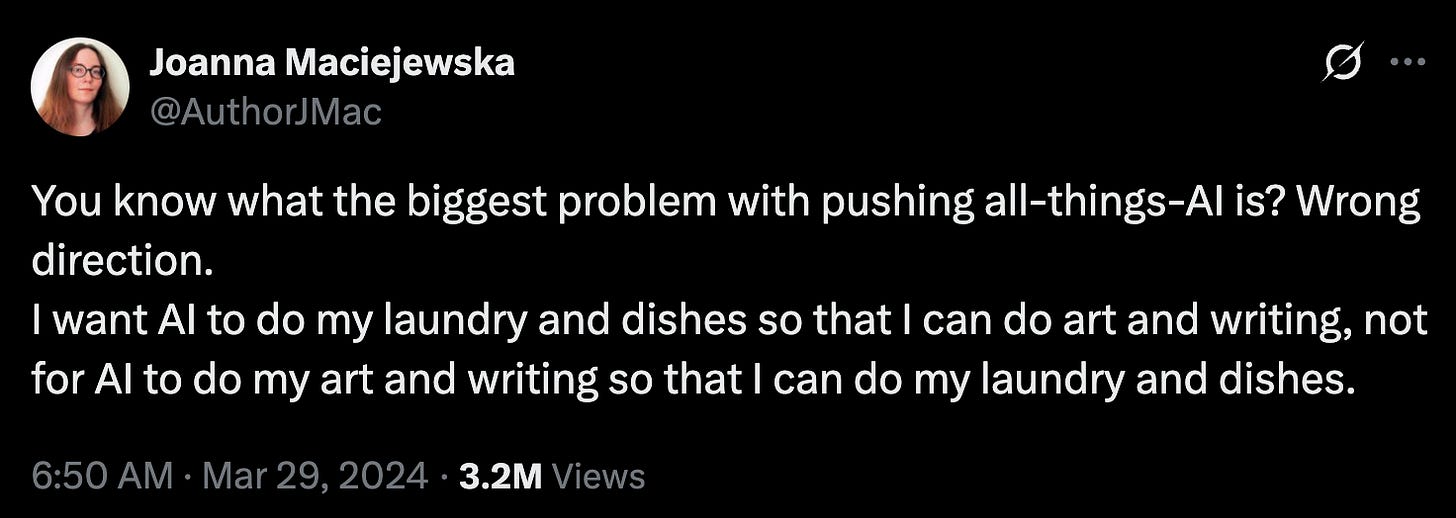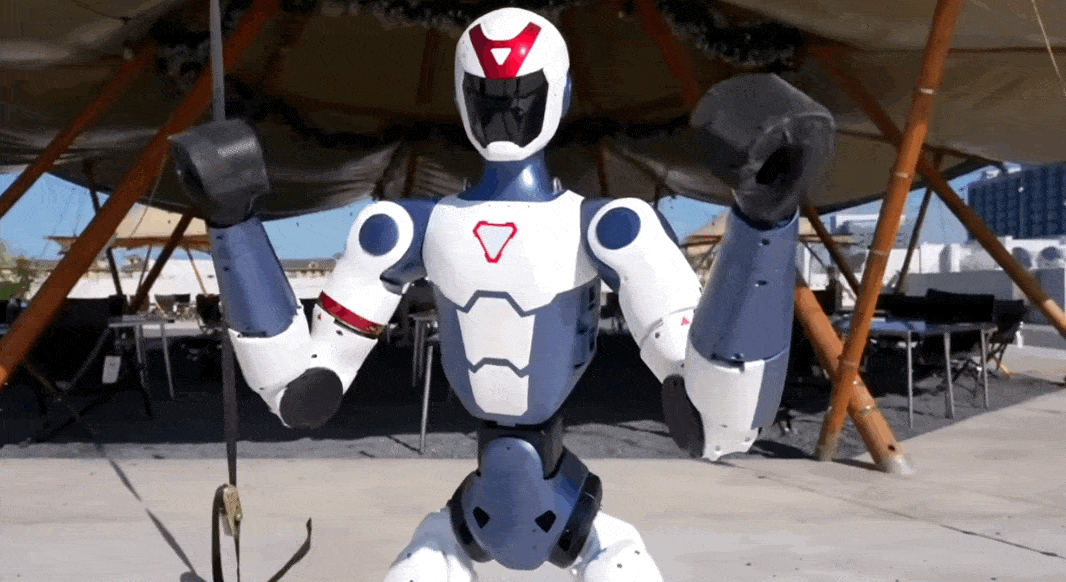Moravec's Paradox: Why AI Writes Poetry While We Do Laundry
How machines became the brain while humans stayed the muscle—and why economics might keep it that way

On March 29, 2024, author Joanna Maciejewska posted a tweet that would be viewed over 3.2 million times:

The tweet captured a frustration millions were feeling: we live in a world where AI can generate stunning artwork and write code, yet we still fold our own laundry and scrub our own dishes. The machines that were supposed to free us from drudgery are instead competing with us in the activities we want to do.
But Joanna's observation isn't just commentary on misplaced priorities—it's an illustration of a counterintuitive principle in AI research. There's a technical reason why AI excels at creating art while struggling with household chores. More importantly, economic forces may ensure that humans continue doing the "simple" physical work while algorithms become our bosses—not because we can't build better robots, but because it's cheaper not to.
The Paradox That Predicted Our Present
In 1988, AI researcher Hans Moravec made an observation that seemed absurd at the time. He wrote that "it is comparatively easy to make computers exhibit adult level performance on intelligence tests or playing checkers, and difficult or impossible to give them the skills of a one-year-old when it comes to perception and mobility."
This became known as Moravec's paradox—the counterintuitive observation that high-level reasoning requires very little computation, while low-level sensorimotor skills require enormous computational resources. In other words: hard things are easy, and easy things are hard.
"The main lesson of thirty-five years of AI research is that the hard problems are easy and the easy problems are hard."
—Steven Pinker
The paradox flipped our intuitions about intelligence. Chess, which we consider a pinnacle of human intellectual achievement, turned out to be straightforward for computers. But walking up stairs, recognizing faces, or manipulating objects—things any toddler can do—proved difficult to automate.
Moravec's explanation was rooted in evolution. The older a skill is in evolutionary terms, the more time natural selection has had to optimize it. Abstract thought developed recently—perhaps less than 100,000 years old. Sensorimotor skills have been evolving for hundreds of millions of years.
"Encoded in the large, highly evolved sensory and motor portions of the human brain is a billion years of experience about the nature of the world and how to survive in it. The deliberate process we call abstract thought or reasoning is, I believe, the thinnest veneer of human thought, effective only because it is supported by this much older and much more powerful, though usually unconscious, sensorimotor knowledge."
—Hans Moravec
We are, in Moravec's words, "prodigious olympians in perceptual and motor areas, so good that we make the difficult look easy." Abstract thought, meanwhile, "is a new trick" that we haven't yet mastered—which is precisely why it's easier to reverse-engineer.
This evolutionary perspective explains why today's AI landscape looks exactly as Joanna's tweet described. Language models like GPT-4 can write poetry and solve complex reasoning problems because these are relatively recent additions to the human cognitive toolkit. But folding laundry or loading a dishwasher requires the kind of fine motor control and spatial reasoning that took evolution hundreds of millions of years to perfect.
The Blind Gymnast Problem
Nowhere is this paradox more visible than in modern robotics. Boston Dynamics robots can perform spectacular backflips and parkour routines that would impress Olympic gymnasts. Yet these same machines struggle with tasks that seem simpler—like placing a fragile item on a shelf or untangling headphones.
Jim Fan, a leading AI researcher, calls this the "mini Moravec's paradox within robotics." We see robots doing spectacular backflips and wonder why they can't fold our clothes. The answer reveals why Joanna's laundry might stay in human hands.
Fan explains that it's easier to train what he calls a "blind gymnast" than a robot that manipulates real-world objects. Acrobatic movements can be solved entirely in simulation—the physics are well-understood and transferable to reality. But dexterity demands "extremely realistic rendering, contact physics, and messy real-world object dynamics—none of which can be simulated well."
"We happen to live in a world where accelerated physics engines are so good that we can get away with impressive acrobatics using literally zero real data. But we haven't yet discovered the same cheat code for general dexterity."
—Jim Fan
When a robot tries to fold a shirt, it must understand fabric properties, predict material behavior, and adapt to countless variations in texture and stiffness. These complex interactions that our evolutionary-optimized systems handle effortlessly remain difficult to simulate.
The Economics of Human Hands
This technical reality is creating an unexpected economic outcome. Rather than robots replacing humans entirely, we're seeing the emergence of hybrid systems where algorithms handle the "thinking" while humans provide the "hands."
Consider Amazon, which operates over 750,000 robots across its fulfillment centers yet still employs over 1.5 million human workers. The robots excel at heavy lifting and systematic sorting, but struggle with "manipulation tasks"—the picking, packing, and handling of individual items. A human can effortlessly grab a phone charger from a crowded bin and place it in a shipping box. For a robot, this requires solving complex problems of object recognition, grasp planning, and force control.
Even Amazon's newest robot, Vulcan—the company's first with a "sense of touch"—operates slower than human workers and struggles with the dexterity that evolution optimized over millions of years.
A 2024 MIT study found that it's often simply too expensive to replace human workers with AI systems. The researchers examined a bakery that could theoretically save $14,000 in labor costs by using AI to monitor ingredient quality. But the cost of developing, implementing, and maintaining such a system made it economically unfeasible.
The result is a division of labor Moravec probably never anticipated: machines become the brain, humans remain the body. In many ways, this represents an optimal allocation of capabilities—machines excel at processing information and coordinating logistics, while humans excel at the physical manipulation that took evolution hundreds of millions of years to perfect.
The Quiet Invitation
But this economic reality reveals a deeper implication that brings us back to Joanna's original frustration. Rather than heading toward a world where robots replace human workers entirely, we seem to be quietly inviting algorithmic bosses to manage us while we continue doing the physical work.
As I explored in an article last year, this transformation is already underway across multiple industries. In Amazon's warehouses, algorithms decide what workers pick and where they go, tracking every moment spent "off task." DoorDash and Uber drivers receive orders, routes, and performance evaluations from algorithmic systems, while they provide the cars and hands needed for delivery. The emerging pattern: algorithms become the brains, humans remain the muscle.
This represents an inversion of our robot apocalypse fears. We worried about machines rising up to subjugate us, forcing us into menial labor while they claimed the intellectual high ground. Instead, we might be inviting them in because the economics make sense—at least for now.
Scale matters here. High-volume operations like Amazon's fulfillment centers might eventually solve the dexterity problem through economic necessity. But household-level tasks? The math becomes much more uncertain.
Moravec's paradox offers two key insights about this moment in AI's evolution. First, the tasks we most want automated—laundry, dishes, cleaning—turn out to be the hardest for robots to master. Second, this difficulty creates economic barriers that could keep these tasks in human hands longer than we might expect, not because the technology is impossible, but because the cost-benefit analysis might never add up.
So will Joanna always be doing her own laundry? The paradox suggests maybe—not because we can't build the laundry robot, but because we might find it's not worth building.



